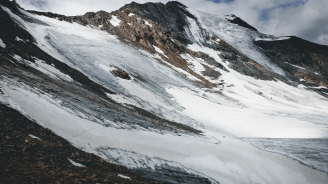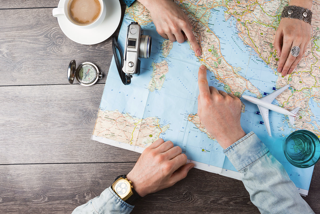Starting point: Ramolhaus
End point: Martin-Busch Hütte
Distance: 12 kilometers
Perfect time: july-august (least amount of snow)
Duration:
– Ramolhaus to Ramoljoch: 30 minutes
– Ramoljoch to junction to Vent: 1 hour – 1.5 hours (depending on conditions of the trail)
– Junction to bridge over waterfall: 1.5 hours
– Waterfall to road in the valley: 1 hour
– Beginning of the road to Martin-Busch: 1.5 – 2 hours
Equipment: Very sturdy hiking shoes, at least type B, walking sticks come in handy sometimes. You could use a via ferrata set to secure yourself on the Ramoljoch (in case of severe fear of heights), but this is not necessary.
Difficulty: The trail requires a certain amount of experience with rugged terrain and long-distance hikes. When there is still a lot of snow, it complicates the hike considerably. The entire climb to the Ramoljoch is secured with cables and stairs, but this is not to be taken lightly. Do not attempt to do this with small children; it is very steep and the staircases are often far apart. The descend consists of a steep slope next to a glacier, covered with big boulders. There might be danger of falling rocks. The rest of the trail is fairly easy.
Alternatives/side tours:
– When you get down to the junction, it is also possible to descend to Vent in about 2-3 hours.
– When you’re very experienced and trained, it is possible to reach the Similaunhütte. This would take about 2 hours extra.
– It is possible to climb the Ramolkogel(s) and then descend further down to the Martin-Busch Hütte.
For more pictures: https://www.instagram.com/_at_worlds_end/
Do you know what it’s like to hear nothing but silence? Nothing but the wings of birds slashing through the air or the whispers of the wind between the grass? Have you ever only smelled the scent of ice and snow hovering between the rocks? Well, if you didn’t, your missing out. There are few things that make me happier, if there are any. Being alone, feeling on top of everything, where the world ends and the universe begins. That’s when you – well I – feel alive.
We were standing on a narrow ridge – the Ramoljoch – overlooking both the places we had been and the ones we were going. The sun was trying to break through the clouds but barely managed. A thin layer of damp mist floated through the air. On our right we could still see yesterday’s glacier and a hint of the cabin we slept in. We could see the abandoned buildings – damaged by an earlier rockslide – we visited a few days ago. We could see the steel cables beneath our feet we conquered only a few minutes ago. On our sides two mountains rose up, crowned by crosses and in memoriam signs. And then we turned to face one of the giants of Austria and started down the rocky slope, the Wildspitze watching over us.
The terrain was rugged like I’d never seen before. Rocks and boulders were clinging to the mountain, but only just. Faint patches of snow were covering the steep trail. We went around to avoid any danger of slipping. An ancient glacier lay next to us, but only traces of it were still visible. It was crumbling before our eyes. Every few minutes a rock slid down, leaving a trail of destruction and deafening sounds in the air. We watched. And I looked onto my elder map, where it said that only ten years ago the trail we were descending did not exist yet. We went on through fields of flowers I’d never seen before. I made sure I took some pictures so I’d remember them. Then when I would be back home, I could browse my grandfather’s dusty alpine books to discover their names. We past a fallen sign, covered by a black plastic sheet. Do not trespass. Danger of falling rocks. Trail will soon be rerouted and reopened. It was handpainted in two languages.
The clouds started to part and some patches of blue sky started to appear. We crossed a fast flowing river and turned away from the crippling glacier. Slowly grass began to show and rocks turned into pebbles. The view changed. We could see the valley below – Vent on our right, the road we had to reach on our left. New mountains rose on the horizon. We hiked through meadows for some time, until the track started to wind down into a steep ravine. I could already hear the sound of water crashing into rocks. A giant waterfall was coming down the mountain. It had carved out its path over thousands and thousands of years and was now buried deep into the flank. A narrow wooden bridge was waiting for us at the end of the descend. I stopped and looked at the water before crossing. It was dazzling and ear-piercing. It’s better not to stare at it for too long. You might get scared.
From the bridge it was only a 500 meter descend that separated us from the road to the Martin-Busch hütte. It’s a long way. And the more we descended, the higher the temperatures got. We lost most of our clothes and got out the sunscreen. It was hot. We were walking next to the river now, on the bottom of the valley. On the other side we could see the road. It was closed. Or at least part of it. Danger of falling rocks – road closed. This time written in four languages. People began to appear. We had been alone for quite some time. This trail was busy. But then again, Martin-bush was not know for its solitude. It was the gate to Italy, to the Similaun and to the fundstelle, the location Ötzi – the 5000 year old Iceman – was found.
Then we could finally turn onto the road and leave the narrow trail and nettles behind. People told us about this part of the journey. Every time you turned a corner you expected to finally see the cabin – and every time you didn’t. I tried not to get my hopes up, not to focus on the road itself but on my map and other features. In the distance, you could see a small bridge, merely a wooden plank. The cabin should be about 400 meters above that bridge. But that bridge was still so far away. We had already covered about 10 kilometers of tough terrain – plus those 8 previous days – so we were quite exhausted. The road was also full of people. Most of them just started off in Vent, so they were still as fit as a fiddle. It was a friday afternoon, tomorrow would be saturday, so they were mostly people heading into the mountains for the weekend.
I think it took us another hour and a half to reach the cabin. All in all, we did pretty good, especially when you take in consideration how sick I had been the previous days. According to the yellow signs it’s about 6 hours from the Ramolhaus to the Martin-Busch hütte. We did it in 6 and a half. There were a lot of people at the cabin. It was completely booked. Over a hundred people would be sleeping there tonight. They showed us the room we would be sleeping in and we unpacked a little. We would be staying for two nights. After unpacking – well, if you call throwing some stuff onto the bed unpacking – we went downstairs to have a well-deserved Apfelschörle. I treated some of my blisters and took another look at the maps for tomorrow. While checking the alitmeter to adjust it, I noticed the height was way off. It hadn’t been before, only a couple of meters when the weather was changing. I suspected I had touched the wheel by accident or something. But then, about five minutes later it started raining. Not just a little. Water was slamming into the wooden floorboards and the stone rooftiles. Everybody fled the terrace. A roaring wind picked up and wrapped itself around the cabin. Everything that was still outside blew away. Never in my life I had seen such forces. It was thrilling to be there at that moment, exciting. At the same time I was so very glad I was inside the cabin, not out. But as sudden as the storm washed over us, it disappeared again. The clouds parted and out came the sun.









